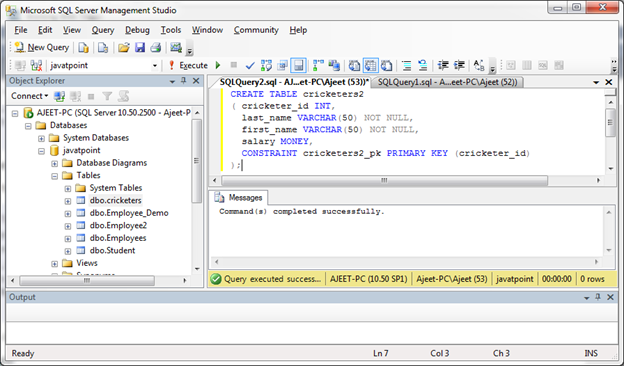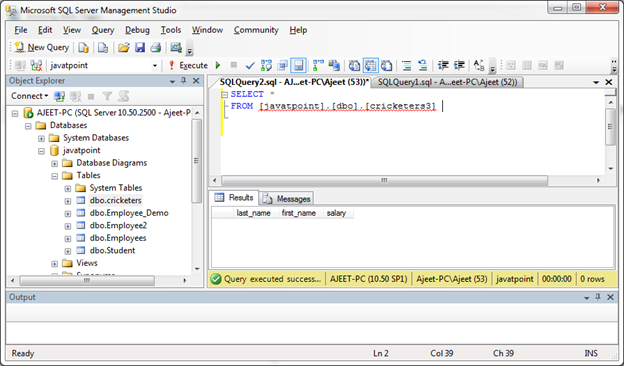SQL Server Primary key is a single field or combination of fields that is used to uniquely define a record. Any field of a primary key cannot contain a null value. A table can have only one primary key.
You can define a primary key either in a CREATE TABLE statement or an ALTER TABLE statement.
Create Primary Key Using CREATE TABLE Statement
CREATE TABLE table_name
(
column1 datatype [ NULL | NOT NULL ] [ PRIMARY KEY ],
column2 datatype [ NULL | NOT NULL ],
...
);CREATE TABLE table_name
(
column1 datatype [ NULL | NOT NULL ],
column2 datatype [ NULL | NOT NULL ],
...
CONSTRAINT constraint_name PRIMARY KEY (column1, column2, ... column_n)
);Example:
Create a table “cricketers” where “cricketer_id” is a primary key.
CREATE TABLE cricketers
( cricketer_id INT PRIMARY KEY,
last_name VARCHAR(50) NOT NULL,
first_name VARCHAR(50) NOT NULL,
salary MONEY
);Output:

You can verify that created table by using SELECT command:
SELECT *
FROM aaa.[dbo].[cricketers]Output:

Here cricketer_id is the primary key.
You can also create a table with primary key by using the second syntax:
CREATE TABLE cricketers2
( cricketer_id INT,
last_name VARCHAR(50) NOT NULL,
first_name VARCHAR(50) NOT NULL,
salary MONEY,
CONSTRAINT cricketers2_pk PRIMARY KEY (cricketer_id)
);Output:

You can verify that created table by using SELECT command:
SELECT *
FROM .[dbo].[cricketers2]Output:

Create a primary key in SQL Server where the primary key is more than one field:
CREATE TABLE cricketers3
( last_name VARCHAR(50) NOT NULL,
first_name VARCHAR(50) NOT NULL,
salary MONEY,
CONSTRAINT cricketers3_pk PRIMARY KEY (last_name, first_name)
);Output:

You can verify that created table by using SELECT command:
SELECT *
FROM .[dbo].[cricketers3]Output:

Here, last_name and first_name both is primary key.
Create Primary Key Using ALTER TABLE statement
You can use an ALTER TABLE statement to create a primary key only on the column or columns that are already defined as NOT NULL.
If a column of a table has NULL values, you cannot add a primary key without dropping and recreating the table.
ALTER TABLE table_name
ADD CONSTRAINT constraint_name PRIMARY KEY (column1, column2, ... column_n);Example:
Create a primary key “cricketer_id” in the table “cricketers2”.
ALTER TABLE .[dbo].[cricketers2]
ADD CONSTRAINT cricketers2_pk PRIMARY KEY (cricketer_id);Output:

It will create a primary key “cricketer_id” in the “cricketers2” table.
Leave a Reply